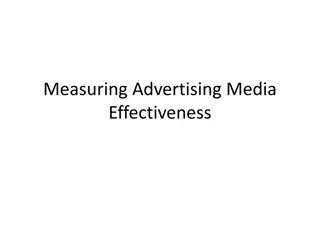
Advanced Data Mining Techniques in Online Algorithms, Bipartite Matching, and Graph Matching
Explore advanced data mining concepts such as online algorithms, bipartite matching, and graph matching. Learn about different matching strategies, optimal solutions, and algorithms for bipartite graphs. Discover the process of online graph matching and its applications in real-world scenarios like task assignments. Enhance your knowledge of efficient matching algorithms and problem-solving techniques in data mining.
Uploaded on | 1 Views
Download Presentation

Please find below an Image/Link to download the presentation.
The content on the website is provided AS IS for your information and personal use only. It may not be sold, licensed, or shared on other websites without obtaining consent from the author. If you encounter any issues during the download, it is possible that the publisher has removed the file from their server.
You are allowed to download the files provided on this website for personal or commercial use, subject to the condition that they are used lawfully. All files are the property of their respective owners.
The content on the website is provided AS IS for your information and personal use only. It may not be sold, licensed, or shared on other websites without obtaining consent from the author.
E N D
Presentation Transcript
CAP5778 CAP5778 Advanced Data Mining Advanced Data Mining Advertising on the Web Advertising on the Web Peixiang Zhao Florida State university Part of the course materials are adapted or revised from Mining of Massive Datasets (mmds.org)
Online Algorithms Online Algorithms Classic model of algorithms You get to see the entire input, then compute some function of it Also known as offline algorithm Online Algorithms You get to see the input one piece at a time, and need to make irrevocable decisions along the way Similar to the data stream model 1
Bipartite Matching Bipartite Matching Boys Girls a 1 2 b c 3 4 d A bipartite graph G Nodes: Boys and Girls; Edges: Preferences Goal: Match boys to girls so that the maximum number of preferences (edges) is satisfied 2
Bipartite Matching Bipartite Matching Boys Girls a 1 2 b c 3 4 d M = {(1,a),(2,b),(3,d)} is a matching Cardinality of matching:|M| = 3 3
Bipartite Matching Bipartite Matching Boys Girls a 1 2 b c 3 4 d M = {(1,c),(2,b),(3,d),(4,a)} is a perfect matching Perfect matching: all vertices of the graph are matched Maximum matching: a matching that contains the largest possible number of matches 4
Bipartite Matching Algorithm Bipartite Matching Algorithm Problem: Given as input a bipartite graph G, find a maximum matching for G Or a perfect matching if it exists Polynomial-time solvable based on the Ford-Fulkerson algorithm for the maximum flow problem Add a source node and the edges from the source to all boy nodes; Add a sink node and the edges from all girl nodes to the sink. The capacity of every edge is 1 The maximum flow is actually the maximal bipartite matching Time complexity: O(V*E) What if we do not know the entire graph upfront? 5
Online Graph Matching Problem Online Graph Matching Problem Problem Setting Initially, we are given the set boys In each round, one girl s choices are revealed That is, girl s edges edges are revealed At that time, we have to decide to either: Pair the girl with a boy Do not pair the girl with any boy Example of application: Assigning tasks to servers 6
Online Graph Matching Online Graph Matching a 1 (1,a) (2,b) (3,d) 2 b 3 c 4 d 7
Online Graph Matching: Greedy Solution Online Graph Matching: Greedy Solution The Greedy scheme Pair the new girl with any eligible boy If there is none, do not pair the girl How good is the algorithm? Competitive ratio For input I, suppose greedy produces matching Mgreedywhile an optimal matching is Mopt Competitive ratio = minall possible inputs I(|Mgreedy|/|Mopt|) The greedy s worst performance over ALL possible inputs I 8
The Greedy Algorithm: Analysis The Greedy Algorithm: Analysis Mopt Consider a case: Mgreedy Mopt Consider the set G of girls matched in Mopt but not in Mgreedy Then every boy B adjacent to girls 1 a 2 b 3 c d 4 in G is already matched in Mgreedy: Otherwise, If there would exist such non-matched boy (by Mgreedy) adjacent to a non-matched girl then greedy would have matched them: contradiction G={ } B={ } Since boys B are already matched in Mgreedythen |Mgreedy| |B| (1) 9
The Greedy Algorithm: Analysis The Greedy Algorithm: Analysis Mopt There are at least |G| such boys (|G| |B|); otherwise, the optimal algorithm couldn t have matched all girls in G So: |G| |B| |Mgreedy| (2) By definition of G also: |Mopt| |Mgreedy| + |G| Worst case is when |G| = |B| = |Mgreedy| Based on (2), we note 1 a 2 b 3 c d 4 G={ } B={ } |Mopt| |Mgreedy| + |G| 2|Mgreedy| then |Mgreedy|/|Mopt| 1/2 10
The Worst The Worst- -case Scenario case Scenario a 1 (1,a) 2 b (2,b) c 3 4 d 11
Web Advertising Web Advertising Banner ads (1995-2001) Initial form of web advertising Popular websites charged $X for every 1,000 impressions of the ad Called CPM (Cost per thousand impressions) CPM rate Modeled similar to TV, magazine ads Low click-through rates A performance metric that measures how often people click on an ad. relative to how many times it is shown Low ROI (Return On Investment) for advertisers 12
Performance Performance- -based Advertising based Advertising Advertisers bid on search keywords When someone searches for that keyword, the highest bidder s ad is displayed Advertiser is charged only if the ad is clicked on Adwards: similar model adopted by Google around 2002 Performance-based advertising works! Multi-billion-dollar industry nowadays Interesting problem: What ads to show for a given query? If I am an advertiser, which search terms should I bid on and how much should I bid? 13
Performance Performance- -based Advertising based Advertising Bidding (offline) Queries (online) Users Search Engine Advertisers Find matching candidates Score candidates Run auction 14
Example Example 15
The The Adwords Adwords Problem Problem Given as input: 1. A set of bids by advertisers for search queries 2. A click-through rate (CTR) for each advertiser-query pair 3. A budget for each advertiser (say for 1 month) 4. A limit on #ads to be displayed with each search query Respond to each search query with a set of advertisers such that: 1. The size of the set is no larger than the limit on #ads per query 2. Each advertiser has bid on the search query 3. Each advertiser has enough budget left to pay for the ad if it is clicked upon 16
The The Adwords Adwords Problem Problem The Problem Setting A stream of queries arrives at the search engine: q1, q2, Several advertisers bid on each query When query qiarrives, search engine must pick a subset of advertisers whose ads are shown Goal: Maximize search engine s revenues Simple solution: Instead of raw bids, use the expected revenue per click (i.e., Bid*CTR) Clearly we need an online algorithm! Queries are endless and unknown The budget of an advertiser is limited and unknown CTR of an ad is unknown (thus measured historically) 17
The The Adwords Adwords Problem Problem Advertiser Bid CTR Bid * CTR A $1.00 1% 1 cent B $0.75 2% 1.5 cents C $0.50 2.5% 1.125 cents Advertiser Bid CTR Bid * CTR B $0.75 2% 1.5 cents C $0.50 2.5% 1.125 cents A $1.00 1% 1 cent 18
The Greedy Solution The Greedy Solution Simplified setting: There is ONE ad shown for each query All advertisers have the same budget B All ads are equally likely to be clicked Value (Expected revenue per click) of each ad is the same (=1) The simplest algorithm is greedy: For a query pick ANY advertiser who has bid 1 for that query Competitive ratio of the greedy solution is 1/2 19
The Worst The Worst- -case Scenario case Scenario Consider two advertisers A and B A x A bids on query x, B bids on x and y Both have budgets of $4 B y Query stream is like x x x x y y y y Consider a greedy choice: B B B B _ _ _ _ Optimal: A A A A B B B B Competitive ratio = 1/2 This is the worst case! 20
Can We Do Better? Can We Do Better? The BALANCE algorithm A x For each query, pick the advertiser with the largest unspent budget B y Break ties arbitrarily (but in a deterministic way but in a deterministic way) Consider two advertisers A and B A bids on query x, B bids on x and y Both have budgets of $4 Query stream is like x x x x y y y y BALANCE choice: A B A B B B _ _ Optimal: A A A A B B B B For BALANCE on 2 advertisers, The competitive ratio = 3/4 21
The BALANCE Algorithm The BALANCE Algorithm Consider, w.l.o.g., a simple case: Two advertisers, A1and A2, each with budget B ( 1) Optimal solution exhausts both advertisers budgets BALANCE must exhaust at least one advertiser s budget: If NOT: There would be some query assigned to neither However, both A A1 1and A A2 2 still have budget At least one advertiser bids on each query, because that query is assigned in the optimal algorithm Contradiction: BALANCE always assigns a query if it can Assume BALANCE exhausts A2 s budget, but allocates x queries fewer than the optimal Revenue: BAL = 2B - x B A1 A2 Optimal Solution neither A A1 1and A A2 2 22
The BALANCE Algorithm The BALANCE Algorithm Queries allocated to A1in the optimal solution Queries allocated to A2in the optimal solution B Optimal revenue = 2B Assume BALANCE gives revenue = 2B-x = B+y A1 A2 Unassigned queries should be assigned to A2 (if we could assign to A1we would since we still have budget) Goal: Show we have y x Consider blue queries (A1 by OPT ) in A1and A2 Case 1) of blue queries (B) is assigned to A1 then ? ?/2, so surely ? ? Case 2) > of blue queries is assigned to A2 then ? ?/? and ? + ? = ? Balance revenue is minimum for ? = ? = ?/? Minimum Balance revenue = ??/? Competitive Ratio = 3/4 x B y x A1 A2 Not used x B y x q A1 A2 23
BALANCE: The General Case BALANCE: The General Case N advertisers: A1, A2, AN, Each with budget B > N Queries: N B queries appear in N rounds of B queries each Bidding: Round 1 queries: bidders A1, A2, , AN Round 2 queries: bidders A2, A3, , AN Round i queries: bidders Ai, , AN Optimum allocation: Allocate round i queries to Ai The optimum revenue N B B A1 A2 A3 24
BALANCE Allocation BALANCE Allocation B/(N-2) B/(N-1) B/N AN-1 A1 AN A2 A3 BALANCE assigns queries in round 1 to N advertisers, queries in round 2 to N-1 advertisers, After k rounds, sum of allocations to each of advertisers Ak, ,ANis ??= ??+1= = ??= ?=1 ? (? 1) If we find the smallest k such that Sk B, then after k rounds, we cannot allocate any queries to any advertiser ? ? 25
BALANCE Allocation BALANCE Allocation At the lowest round k such that 1 ?+ 1 1 B ? 1+ + ?. ? ? + 1 That is, 1 ?+ 1 1 ? 1+ + ? ? + 1 1. Approximately, ? 1 ? ln? ln ? ? 1 because ln? ?=1 So, ? = ?(1 1 ?) The approximate revenue by BALANCE is BN(1 1/e), and the competitive ratio is 1 1/e, or approximately 0.63 26
Thank you Thank you






















